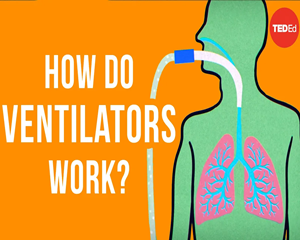In the 16th century, Flemish physician Andreas Vesalius described how a suffocating animal could be kept alive by inserting a tube into its trachea and blowing air to inflate its lungs.
十六世纪,弗拉芒医生安德烈·维萨里描述了通过将管子插入气管并向肺部吹入空气,让窒息的动物活下来的方法。
In 1555, this procedure didn't warrant much acclaim.
在1555年,这种方式并未得到多少认可。
But today, Vesalius's treatise is recognized as the first description of mechanical ventilation -- a crucial practice in modern medicine.
但如今,维萨里的论述被认为是首次对于机械呼吸机的描述--这是当代医学中一项重要的治疗手段。
To appreciate the value of ventilation, we need to understand how the respiratory system works.
要理解呼吸机的价值,我们需要了解呼吸系统是如何运作的。
We breathe by contracting our diaphragms, which expands our chest cavities.
我们通过收缩横膈膜来扩张胸腔呼吸。
This allows air to be drawn in, inflating the alveoli -- millions of small sacs inside our lungs.
于是空气被吸进来,充满肺泡--肺泡是我们肺部成千上万的小囊。
Each of these tiny balloons is surrounded by a mesh of blood-filled capillaries.
每个这样的小球都被充满血液的网状毛细血管包围着。
This blood absorbs oxygen from the inflated alveoli and leaves behind carbon dioxide.
血液从充气的肺泡中吸收氧气,并释放二氧化碳。
When the diaphragm is relaxed, the CO2 is exhaled alongside a mix of oxygen and other gases.
当横膈膜放松时,二氧化碳同氧气以及其他气体一同被呼出体外。
When our respiratory systems are working correctly, this process happens automatically.
当我们的呼吸系统正常运作时,这一过程会自动发生。
But the respiratory system can be interrupted by a variety of conditions.
但是该过程也会因多种因素中断。
Sleep apnea stops diaphragm muscles from contracting. Asthma can lead to inflamed airways which obstruct oxygen.
睡眠窒息症会让横膈膜肌肉停止收缩。哮喘会导致气道发炎,进而阻碍氧气的流通。
And pneumonia, often triggered by bacterial or viral infections, attacks the alveoli themselves.
肺炎--常常由细菌或病毒感染引发--会攻击肺泡本身。
Invading pathogens kill lung cells, triggering an immune response that can cause lethal inflammation and fluid buildup.
外来病原体会杀死肺细胞,引发免疫反应,可能会导致致命的炎症和肺部积液。
All these situations render the lungs unable to function normally.
所有这些情况都会让肺部无法正常运作。
But mechanical ventilators take over the process, getting oxygen into the body when the respiratory system cannot.
但是机械呼吸机替代了这一过程,在呼吸系统无法正常工作时让氧气进入身体。
These machines can bypass constricted airways, and deliver highly oxygenated air to help damaged lungs diffuse more oxygen.
呼吸机可以绕过受阻的气道,传递富氧空气来帮助受损的肺扩散更多氧气。
There are two main ways ventilators can work -- pumping air into the patient's lungs through positive pressure ventilation,
呼吸机有两种主要的工作方式--通过正压式呼吸将空气冲入病人肺部,
or allowing air to be passively drawn in through negative pressure ventilation.
或通过负压式呼吸让空气被动吸入。
In the late 19th century, ventilation techniques largely focused on negative pressure,
十九世纪晚期的呼吸机技术主要为负压式呼吸,
which closely approximates natural breathing and provides an even distribution of air in the lungs.
这一过程模拟了自然呼吸,并保证了肺部均匀的空气分布。

To achieve this, doctors created a tight seal around the patient's body, either by enclosing them in a wooden box or a specially sealed room.
为了实现这一目标,医生会在病人身体周围构造密闭空间,比如将病人放在木盒或特殊的密闭房间内。
Air was then pumped out of the chamber, decreasing air pressure, and allowing the patient's chest cavity to expand more easily.
然后,空气从密室中被吸出,降低气压,使得病人的胸腔能更容易扩张。
In 1928, doctors developed a portable, metal device with pumps powered by an electric motor.
在1928年,医生发明了一种便携式金属装置,气泵由电动机供能。
This machine, known as the iron lung, became a fixture in hospitals through the mid-20th century.
这一装置,也就是俗称的“铁肺”,成为了二十世纪中期医院中的常备装置。
However, even the most compact negative pressure designs heavily restricted a patient's movement and obstructed access for caregivers.
但是,即使是最小巧的负压式呼吸机也会大大限制病人的移动,妨碍看护人员的工作。
This led hospitals in the 1960's to shift towards positive pressure ventilation.
这使得医院在六十年代转而开始使用正压式呼吸机。
For milder cases, this can be done non-invasively. Often, a facemask is fitted over the mouth and nose, and filled with pressurized air which moves into the patient's airway.
对于较轻的病症,正压式呼吸可以通过非侵入的方式实现。通常用面罩覆盖口鼻,并将加压空气注入病人的气道。
But more severe circumstances require a device that takes over the entire breathing process.
但对于更加严重的状况,则需要能够接管整个呼吸过程的装备。
A tube is inserted into the patient's trachea to pump air directly into the lungs, with a series of valves and branching pipes forming a circuit for inhalation and exhalation.
一根管子会被插入病人的气管,向肺部直接打入空气,并通过一系列的气阀和支管形成吸气和呼气的回路。
In most modern ventilators, an embedded computer system allows for monitoring the patient's breathing and adjusting the airflow.
在最现代的呼吸机中,内嵌的电脑系统可以监控病人的呼吸,并调整气流。
These machines aren't used as a standard treatment, but rather, as a last resort.
这些机器并不是常规治疗手段,而是最后的救命稻草。
Enduring this influx of pressurized air requires heavy sedation, and repeated ventilation can cause long-term lung damage.
忍受加压空气的流入需要大剂量的镇定剂,而且重复的换气可能会导致长期的肺部损伤。
But in extreme situations, ventilators can be the difference between life and death.
但在极端情况下,呼吸机就是生与死的差别。
And events like the COVID-19 pandemic have shown that they're even more essential than we thought.
譬如新冠肺炎大流行的情况就证明了它们比我们想象的更重要。
Because current models are bulky, expensive, and require extensive training to operate, most hospitals only have a few in supply.
因为现有的呼吸机模型笨重且昂贵,还需要大量的训练才能安全操作,大部分医院只配备了少量几台呼吸机。
This may be enough under normal circumstances, but during emergencies, this limited cache is stretched thin.
这在一般情况下可能够用了,但在紧急情况下,这样的配置就捉襟见肘了。
The world urgently needs more low-cost and portable ventilators, as well as a faster means of producing and distributing this life-saving technology.
世界亟需更多廉价的便携式呼吸机,以及能够更快速的生产和分配这种救命技术的手段。













